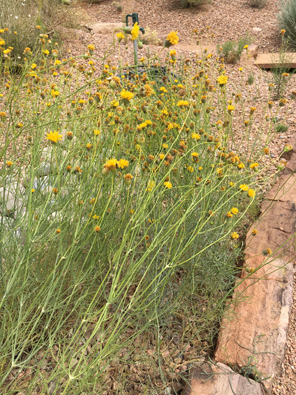 |
 |
Description
"Thelesperma megapotamicum is a perennial species of flowering plant in the aster family known by the common name Navajo tea greenthread[1] and rayless greenthread. It is native to sections of the Americas, including the central United States, where it grows in many types of habitat. It is a perennial herb producing a slender, branching stem 30 to 60 centimeters tall or more. The leaves are narrow, mostly compound with linear or threadlike segments measuring a few centimeters long. The inflorescence bears several flower heads each in a cuplike involucre of phyllaries with purple-tinged, pointed lobes with white edges. The head contains many yellow or orange disc florets, and sometimes one or more yellow ray florets, although these may be absent.
Native American groups such as the Hopi and Navajo use this plant to make herbal teas, as a medicinal remedy and a yellow dye.[2] The Hopi name for this plant is Hohoysi. The plant can be boiled whole until the water turns a rusty color and used as a tea. In addition, the Hopi people also add the plant, along with water, into large glass jars and place in the sun to make sun tea.[3]" (Wikipedia)
Ethnobotanical Uses
Food:
"As the name implies, the main use of this plant is for brewing a tea, and a delicious one at that. In our area virtually all the Pueblo tribes, as well as the Navajo and Apache, know this plant and consider it to be the best of several plant species for making tea.
The stems and flowers are tied in bundles, then hung to dry for use throughout the year, but especially in winter. When steeped in boiling water a vivid orange to amber-colored beverage results. The taste resembles some commercial green teas and is very reminiscent of a popular tea made from the bark of the native sassafras tree in the eastern United States." (Dunmire and Tierney 223-4)
Medicine:
"Indian tea acts as a mild diuretic and seems to have other medicinal attributes. It has been used by Tewa and Santo Domingo Puebloans for stomach disorders and muscle cramps and by the Cochiti Indians for colds 'instead of aspirin.' " (Dunmire and Tierney 224)"
"It is used with malva (Malva neglecta) as a skin wash for diaper rash and thrush." (Moore 65)
Other Uses:
"The Hopi, Navajo, and, possibly, Zuni have combined parts of this plant with several other wild species to manufacture a yellow or gold dye, but there is no record for dye use among Rio Grande Puebloans." (Dunmire and Tierney 224)
"Since the tea is reddish brown, it was formerly used as a dye to color 'the stems of rabbitbrush for the patterns of the wicker plaques of the Moki Indians of Northern Arizona. --- A yellow dye is also made from its flowers." (Moore 57-8)